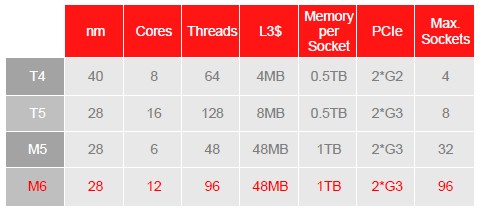This article is more than 1 year old
The firm that swallowed the Sun: Is Oracle happy as Larry with hardware and systems?
One swallow didn't make a summer
Servers
Oracle took in Sun when it was shipping its T2-series servers and has since introduced three more generations of the T-series:
- 1-4 socket T3 in December 2010 with 1.65GHz CPUs, 8 or 16 cores, and up to 512GB of memory
- 1-4 socket T4 in September 2011 with 2.85GHz CPUs, 8 cores and 8 threads/core, and up to 1TB of memory (per 4 CPUs)
- 1-8 socket T5 in March 2013, clocking in at 3.6GHz, 16 cores and 8 threads/core, with up to 4TB of memory (per 8 CPUs)
Viewing this as a schedule, we can expect a T6 rollout later this year.
Remember when?
At acquisition time, Sun made STARC T2 chips with Fujitsu making Sparc64 processors. Fujitsu carried on making SPARC chips but Oracle indicated it would stop using them, via the M (= mainframe) mid-range and big-iron servers, with the T5 launch.
This OEM supply of Fujitsu SPARC chips has weakened Oracle’s own SPARC-based system profitability, although it has provided a broader hardware supply for Solaris software to run on and hence encouraged Solaris app development.

Compare and contrast Oracle’s T4, T5, M5 and M6 processors. Could the T6 have 1TB/socket of memory?
The 3.6GHz M6 CPU was announced in August 2013 and only supports Solaris, not Linux. It shared its S3 core with the T5 processor.
The M7 processor was revealed in August last year, featuring 32 cores (4 x 8-core clusters), and connectability in a 32-node SMP setup for a total of 1,024 cores. Systems using it are expected later this year.
Oracle says its SPARC servers are best for mission-critical apps with the X86 systems best for running Oracle SW on X86 hardware. Well, yes, it would say that, wouldn’t it.
The X86 products have kept up with Intel processor roll-outs and Oracle argues they have a lower total cost of ownership than competing systems from HP and IBM (Lenovo).
Operating systems
There are two: Solaris, Sun’s own version of Unix, and Oracle Linux. Solaris runs on SPARC and X86 servers and includes DTrace analytics, the ZFS file system, containers and other facilities.
Once Oracle bought Sun, with Solaris v10, it discontinued the OpenSolaris open source project in 2010 and stopped providing kernel updates. Some open source components can still be downloaded from Oracle.
Solaris 11 came out in 2011 with ZFS deduplication and SPARC T4 support. V11.1 was delivered in October 2012, and 11.2 with full OpenStack support and an integrated hypervisor in April 2014.
Oracle Linux, containing the Oracle Unbreakable Enterprise Kernel, is a repacked Red Hat Enterprise Linux distribution with over 11,000 customers on subscribed support. It is used in the Exadata, Exalytics, Exalogic, Database and Big DataAppliance engineered systems. By using X86 hardware and Linux, Oracle can ride the commodity hardware, open software compatibility wave.
Oracle has added DTrace and Clusterware to it, amongst other capabilities.
Engineered systems
Oracle wanted to build integrated systems when it took over Sun and its X86 and SPARC servers plus the Solaris OS. It had integrated stacks from apps to hardware in mind. Oracle has nine engineered systems:
- Exadata Database Machine
- Exalogic Elastic Cloud based on the Exadata server
- Exalytics In-Memory Machine
- Database Appliance, a compressed Exadata cluster launched in 2011
- Virtual Compute Appliance to run Oracle virtual machines with included ZFS storage
- Big Data Appliance with Cloudera software
- ZFS Storage Appliance
- Oracle SuperCluster general purpose system
- Zero Data Loss Recovery Appliance to protect Oracle databases
These are hyperconverged systems with integrated middleware (database, etc) and system software as well as server, storage and internal networking hardware – predating systems from Nutanix and Simplivity, which don’t generally include middleware.
Oracle saw early on that it was worth integrating commodity hardware and its software to get its apps running much faster
